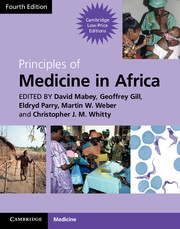Book contents
- Frontmatter
- Contents
- Contributors
- Foreword
- Section 1 Health and disease
- Section 2 Mother and child health
- Section 3 Infection: general principles
- Section 4 Major common infections
- 16 Malaria
- 17 HIV/AIDS
- 18 Tuberculosis
- 19 Pneumonia in adults
- 20 Meningitis
- 21 Sexually transmitted infections
- Section 5 Bacterial infections
- Section 6 Viral Infections
- Section 7 Protozoal infections
- Section 8 Helminth infections
- Section 9 Fungal infections
- Section 10 Non-communicable diseases
- Section 11 Diseases of body systems
- Section 12 Cancer and Palliative Care
- Section 13 Venoms and Poisons
- Index
- References
17 - HIV/AIDS
from Section 4 - Major common infections
Published online by Cambridge University Press: 05 March 2013
- Frontmatter
- Contents
- Contributors
- Foreword
- Section 1 Health and disease
- Section 2 Mother and child health
- Section 3 Infection: general principles
- Section 4 Major common infections
- 16 Malaria
- 17 HIV/AIDS
- 18 Tuberculosis
- 19 Pneumonia in adults
- 20 Meningitis
- 21 Sexually transmitted infections
- Section 5 Bacterial infections
- Section 6 Viral Infections
- Section 7 Protozoal infections
- Section 8 Helminth infections
- Section 9 Fungal infections
- Section 10 Non-communicable diseases
- Section 11 Diseases of body systems
- Section 12 Cancer and Palliative Care
- Section 13 Venoms and Poisons
- Index
- References
Summary
In 1982, physicians in South West Uganda noticed a new disease with prominent symptoms of weight loss and diarrhoea, known locally as slim disease, and in 1983 patients with opportunistic infections and Kaposi's sarcoma (KS) were identified in hospitals in Rwanda and Zaire. These observations were made shortly after reports of clusters of unusual diseases associated with profound immunosuppression among men who had sex with men in the United States. These reports were the first to draw public attention to the acquired immunodeficiency syndrome (AIDS), initially as an unusual new disease, and now undoubtedly the greatest challenge to global public health in recent years.
The problem in Africa
The global burden of HIV disease continues to fall most heavily in sub-Saharan Africa, home to around two-thirds of the 33.3 million people estimated to be living with HIV/AIDS in 2010 (Fig. 17.1) (UNAIDS). Since 2000, the global epidemic has stabilized and HIV prevalence is declining in many countries. The number of new HIV infections in African countries peaked in the mid-1990s, and has subsequently declined. AIDS-related mortality in Africa has also declined since 2004, at least partly attributable to remarkable achievements in expansion of access to effective treatment with antiretroviral therapy (ART). In 2009, nearly 37 per cent of people in Africa needing ART received it. Wider coverage of ART is now reducing adult mortality at population level (Floyd et al., 2010), but HIV continues to be a major cause of death among young adults: AIDS remains the largest cause of maternal mortality in South Africa. The principal challenges remain to reduce the number of new cases of HIV infection occurring, and to deliver effective care for the millions already living with the virus.
- Type
- Chapter
- Information
- Principles of Medicine in Africa , pp. 195 - 231Publisher: Cambridge University PressPrint publication year: 2013



